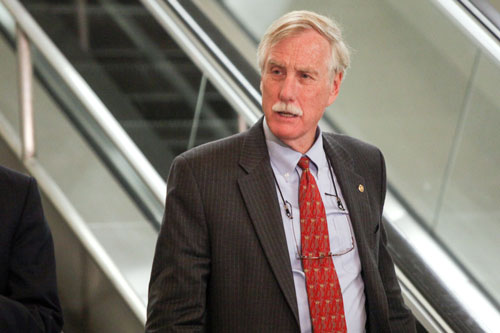Personal Wealth Management / Market Analysis
Inside Glass-Steagall’s Latest Comeback Attempt
The latest attempt to reinstate Glass-Steagall wouldn’t be great for capital markets, but—thankfully—it stands little chance of passing.
Freshman Senator Angus King, one of three senators aiming to revive Glass-Steagall. Photo by Allison Shelley, Getty Images.
Last Thursday, Senators Elizabeth Warren (D-MA), John McCain (R-AZ) and Angus King (I-ME) proposed a new bill to the Senate Banking Committee: the “21st Century Glass-Steagall Act of 2013.” Like other recent financial services reform bills (most recently Brown-Vitter), it aims to make the financial system “safe,” prevent another taxpayer-funded bailout, reduce moral hazard, insulate retail bank deposits from investment banks’ trades and end “too big to fail.” And, like these bills, it would likely introduce myriad unintended consequences without accomplishing its stated aims—but since it stands little chance of passing, its capital markets risk appears minimal.
Specifically, the bill would repeal the Gramm-Leach-Bliley Act, which suspended Glass-Steagall, and separate traditional banking from investment banking—similar to the Volcker Rule, but with more teeth. Instead of ring-fencing bank holding companies’ retail or investment banking units, it would build a full firewall, prohibiting FDIC-insured institutions from insurance, securities or swaps activities. Insurance underwriting/issuance; securities/debt underwriting; market making; broker/dealer activities; futures, options and swaps market activities; investment advisory (including hedge funds and private equity); and investment in any entity engaged in any of these activities. It would also remove any board members associated with any insurance, securities or swaps entity.
Overall, it’s a rather misguided endeavor. Glass-Steagall wouldn’t have prevented the cascade of failures and bailouts in 2008. For it to have had an impact, at least one major retail-investment bank conglomerate would have to have failed—but none did. Not one. Lehman Brothers was a pure investment bank. Washington Mutual was essentially a thrift. AIG was an insurer. Fannie Mae and Freddie Mac were government-sponsored mortgage underwriters. In fact, creating megabanks was US policymakers’ favored solution in 2008! The Fed married Bear Stearns off to JP Morgan, and the regulators deemed the merger of Merrill Lynch and Bank of America deemed necessary to restore financial system sanity. That the solution is now considered a problem is perplexing, to say the least.
More problematic though are the potential unintended consequences. It would limit liquidity in every capital market—including stocks and bonds—with derivatives taking the hardest hit. This would likely drive liquidity spreads (costs) to unreasonable levels, reducing businesses’ and individual investors’ ability to hedge. Plus, by limiting banks’ potential business activities, the proposed bill would remove key sources of profit and risk management, which would weigh on Financials, lending and overall capital markets activity over time. It could also make M&A underwriting more difficult, potentially impeding corporate actions. In short, it likely wouldn’t be a net benefit for Wall Street or Main Street.
Positively, the proposal probably won’t go far—and not just because current gridlock lowers the likelihood of extreme legislation passing. Previous bills to revive Glass-Steagall were defeated or stalled in committee during 2009’s Dodd-Frank discussions, and a 2010 Dodd-Frank amendment to limit bank size lost 61-33. April’s Brown-Vitter bill, which tries to limit bank size through onerous capital requirements, hasn’t gained meaningful support. Moreover, given the time and effort many Senators and regulators have put into Dodd-Frank’s implementation—and presented with the fact banks have more capital and liquidity now than any time in the past 30 years—lawmakers seem unlikely to U-turn on Dodd-Frank and pursue this bill. Even Senator Warren expects it to have limited endorsement.
So why submit it at all? In short, it’s a political play. This bill, like Brown-Vitter, seems an avenue for certain Senators to fulfill key campaign pledges to crack down on the banks—“at least we tried,” they can tell voters when they’re up for re-election. Politicking may persist for a while, but markets likely shrug off the theatrics, with Financials and broader equities moving higher on the back of strong fundamentals.
If you would like to contact the editors responsible for this article, please message MarketMinder directly.
*The content contained in this article represents only the opinions and viewpoints of the Fisher Investments editorial staff.
Get a weekly roundup of our market insights
Sign up for our weekly e-mail newsletter.

You Imagine Your Future. We Help You Get There.
Are you ready to start your journey to a better financial future?

Where Might the Market Go Next?
Confidently tackle the market’s ups and downs with independent research and analysis that tells you where we think stocks are headed—and why.






